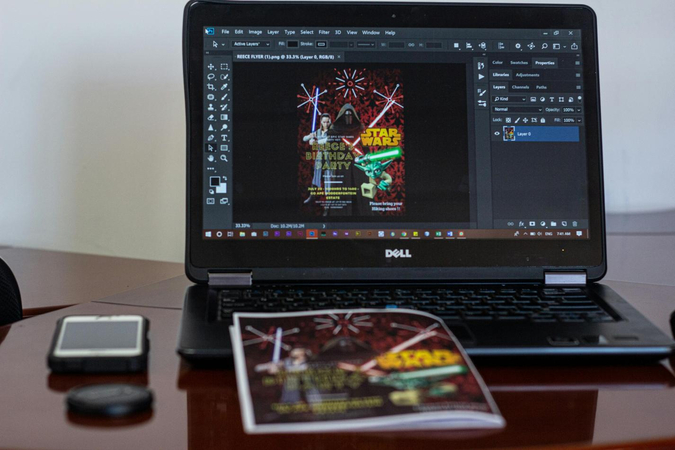The Complete Guide to Cinematic Effect: Grain Filter Secrets
At the very beginning of any journey into creative photo editing, one cannot ignore the impact and timeless appeal of the grain filter. Once considered a flaw in traditional film photography, grain has evolved into a beloved aesthetic choice among modern digital creators. Its distinct, textural quality adds richness, mood, and character that are hard to replicate with other effects.
This guide will take you deep into the world of grain filters-exploring what they are, how they differ from digital noise, when to use them, and how to apply them using the best available tools. Whether you're looking to capture the magic of a rainy filter, achieve the cinematic magic of film, or simply add grain to photo edits to make them stand out, this guide will serve as your complete resource.
Part 1: Overview of Grain Filters

Grain filters replicate the granular textures found in traditional film photography. Unlike modern digital clarity, which prioritizes smoothness and detail, grain brings an organic, raw, and sometimes even gritty look to your photos. This nostalgic aesthetic appeals not only to photographers but also to social media users, influencers, and digital artists who want their visuals to tell a deeper story.
While digital photography strives for perfection, there is something irresistibly human about the imperfections created by grain. The photo grain effect adds subtle speckles across the image, mimicking the chemical process of analog film. The grain filter doesn't just change the visual texture; it alters the emotional tone. It can make an image feel old, timeless, or even cinematic, transporting the viewer to a different time or state of mind.
What is Grain Filter?
A grain filter is a digital overlay or effect used in image editing software that mimics the random, textured appearance of film grain. This effect was once an unavoidable part of using analog film, caused by the physical makeup of film stock, which contained light-sensitive particles. Today, however, this feature is re-created digitally for stylistic reasons.
What makes grain special is its intentional imperfection. Unlike sharpness or saturation adjustments, grain doesn't "improve" a photo by traditional metrics-it enhances the feeling. A lightly grained portrait might evoke intimacy, while a heavily grained street photo might feel gritty and cinematic. Whether you're using a DSLR, smartphone, or mirrorless camera, the grain filter gives your photos a visual "story" that connects emotionally with viewers.
Types of Grain Filters
Film Grain
Film grain is designed to simulate the natural grain found in traditional film photography. This type of grain filter is especially popular among professional photographers and filmmakers who want to recreate the look of classic cinema. Film grain tends to be more uniform and less harsh than digital noise. It enhances depth without drawing attention to itself, blending smoothly into shadows and highlights.
Using a film grain filter can make your photo look like it came from a movie still or a vintage magazine. When applied correctly, it enhances rather than distracts, especially in black-and-white or muted color images.
Grain
This is the standard grain filter available in most photo editing apps. It's a simple texture layer that adds a soft fuzziness to your image. While not necessarily realistic like film grain, it is versatile and easy to apply. This type of grain filter works well for social media posts, portraits, and even food photography when you're aiming for a cozy, analog look.
Scattered Grain
Scattered grain is a less uniform texture that creates a more dramatic or experimental visual effect. Unlike the evenness of film grain, scattered grain places varying intensities of grain throughout the photo. This can add drama and intrigue to abstract, urban, or conceptual photography. For example, when combined with a rainy filter, scattered grain can enhance the moodiness of a stormy cityscape or a brooding portrait.
Benefits of Using Grain Filters
Grain filters offer a variety of benefits that extend beyond mere aesthetics. First and foremost, they can help communicate emotion in a photo. A picture with a smooth finish might look beautiful, but one with grain can feel alive. It has character, depth, and a certain timelessness.
Another benefit is their ability to cover up imperfections. Say your photo is slightly blurry or was taken in poor lighting-adding a bit of grain can make it look deliberate and artistic rather than flawed. This is particularly helpful in smartphone photography, where image quality can vary based on the device and conditions.
Grain also pairs wonderfully with other creative filters. For instance, layering grain with a rainy filter can simulate the feeling of old rain-streaked film, creating a dramatic and emotional atmosphere. If you're curating a moody Instagram theme or experimenting with retro styles, grain filters are invaluable tools for achieving the desired aesthetic.
Finally, the grain filter makes your digital photos feel tangible. It adds texture and movement, making the viewer feel like they're touching a piece of printed film rather than staring at pixels.
When to Use Grain Filters
Artistic Effects
For artistic photography, grain filters offer unmatched creative freedom. If your goal is to produce evocative or emotional imagery, grain is often the perfect finishing touch. It softens edges, blends colors subtly, and gives your work a painterly effect that can make your photos feel like art pieces rather than snapshots.
Vintage/Retro Looks
This is where grain truly shines. When you're trying to recreate the look of older cameras-from Polaroids to disposable film-the grain filter is essential. It replicates the imperfections that give vintage photos their charm. Combine grain with desaturated colors and vignetting, and you'll transport your viewers straight back to the 1970s.
The instagram grain filter trend is largely based on this retro aesthetic. Popular among influencers, it's used to give selfies and lifestyle shots a unique, throwback vibe that makes posts stand out in a sea of high-res content.
Adding Texture and Depth
Digital images can often feel too perfect-too clean. Adding grain introduces texture, a kind of visual "grit" that gives the photo physicality and emotion. It can make a photo feel like it has layers, drawing the viewer deeper into the scene. This works especially well in black-and-white photography, where grain mimics the rawness of classic film.
Examples of Use Cases
- Portraits that require emotional or artistic expression
- Landscape shots under moody or overcast lighting
- Fashion photography aiming for a retro editorial feel
- Street photography where ambiance and character matter more than sharpness
Tips for Using Grain Filters Effectively
Moderation is Key
The most common mistake people make with grain filters is overusing them. A little grain goes a long way. Unless you're going for an intense experimental style, you should aim for subtlety. Begin with low settings and increase gradually until you find the right balance.
Consider the Overall Aesthetic
Grain should complement, not contradict, your photo's mood. For instance, a light, sunny portrait may not benefit from heavy, gritty grain. On the other hand, an emotional black-and-white image might thrive with extra texture. Think of grain as part of a larger visual story.
Pair with Other Editing Tools
Grain doesn't need to stand alone. Combine it with warm filters, fades, or the popular rainy filter to evoke specific moods. Even simple enhancements like contrast adjustments or light leaks can make grain feel more natural and integrated into your final image.
Experiment with Different Grain Types
Each type of grain filter behaves differently, and what works for one image might not work for another. For example, scattered grain might be too dramatic for a family portrait but perfect for an abstract urban scene. Try them all to see what matches your vision.
What's the Difference Between 'Grain' and 'Noise'?
This is a crucial distinction. Grain and noise might appear similar, but are entirely different in both function and intention.
Grain, as discussed, is deliberately added for style. It is usually fine, consistent, and organic. It brings charm and narrative texture to the image. On the other hand, noise is a byproduct of camera sensors struggling in low light. It's often blotchy, harsh, and damaging to image quality.
Editing tools allow you to reduce noise while still adding grain. This is particularly useful for night photography, where sensor noise is prevalent. Using AI-powered tools, you can clean the image and then intentionally add grain to maintain aesthetic value.
Part 2: How to Add Grain Filters to Your Photos

Adding grain is a quick and effective process in most modern editing apps. Here's how to do it:
- 1. Select an Editing App:Apps like Lightroom, Snapseed, VSCO, and Facetune all offer grain tools. Facetune even has a tutorial specifically for how to add grain to photo edits with minimal effort.
- 2. Import Your Photo:Choose the image you want to work on.
- 3. Locate the Grain Option:Usually under the "Effects" or "Texture" tab.
- 4. Adjust the Strength:Start with a light grain level and increase only if the photo needs it.
- 5. Preview and Save:Always check how the grain looks in both full-size and thumbnail views before exporting.
Part 3: An Amazing AI Filter Tool Recommendation
HitPaw Photo Enhancer is an excellent AI tool designed for fast, efficient, and high-quality image editing. It's especially useful for users who want to apply effects like grain without manually adjusting every parameter.
What is HitPaw Photo Enhancer?

HitPaw uses AI algorithms to automatically enhance image quality. It can:
- Sharpen blurry photos
- Remove unwanted noise
- Improve resolution
- Apply effects like thephoto grain effect seamlessly
HitPaw is beginner-friendly, making it ideal for influencers, content creators, or casual users who want fast, professional-grade results without mastering complex software.
Part 4: Conclusion
Grain filters are not just visual tweaks-they are storytelling tools. They help infuse your images with personality, atmosphere, and emotional depth. Whether you're channeling the retro charm of film photography, creating cinematic landscapes, or simply trying to soften the sterility of digital images, grain offers an elegant solution.
So go ahead-open your editing app or AI tool and start experimenting with grain filters today. You'll be surprised at how much more powerful and evocative your photos can become.










 HitPaw Univd (Video Converter)
HitPaw Univd (Video Converter) HitPaw VoicePea
HitPaw VoicePea  HitPaw VikPea (Video Enhancer)
HitPaw VikPea (Video Enhancer)



Share this article:
Select the product rating:
Daniel Walker
Editor-in-Chief
This post was written by Editor Daniel Walker whose passion lies in bridging the gap between cutting-edge technology and everyday creativity. The content he created inspires the audience to embrace digital tools confidently.
View all ArticlesLeave a Comment
Create your review for HitPaw articles